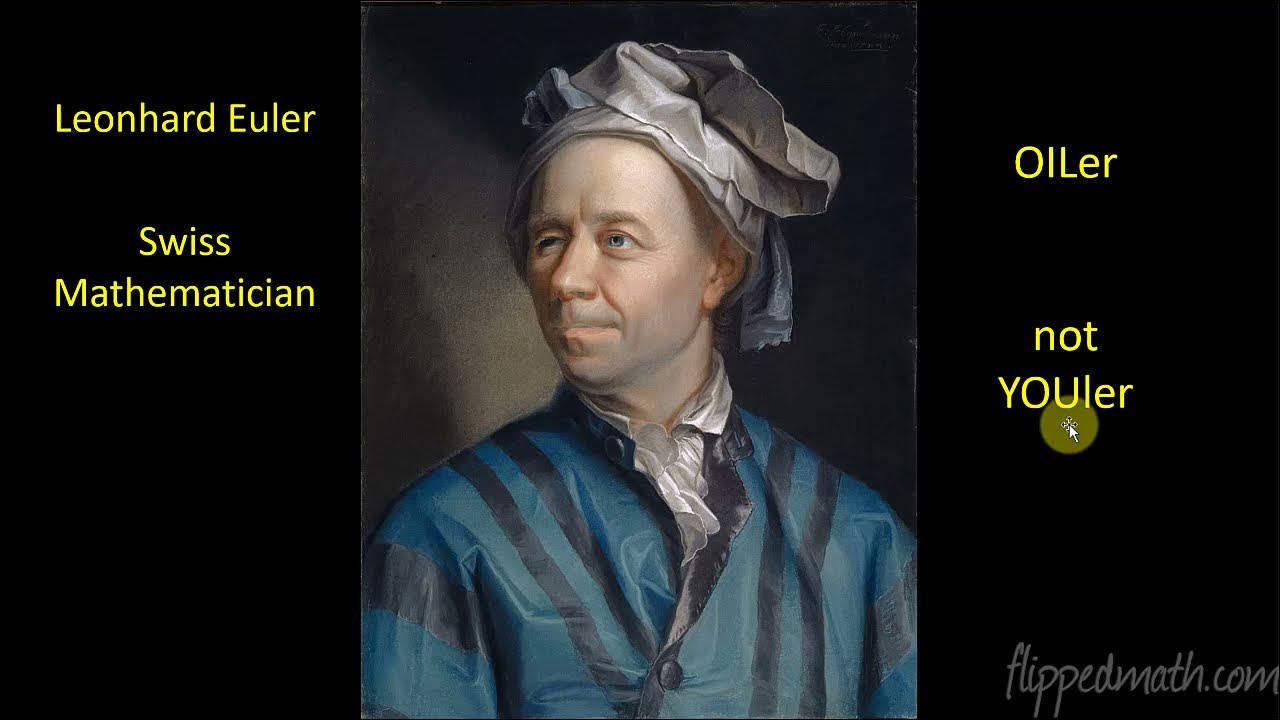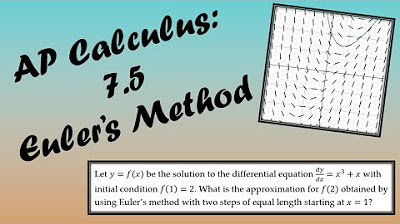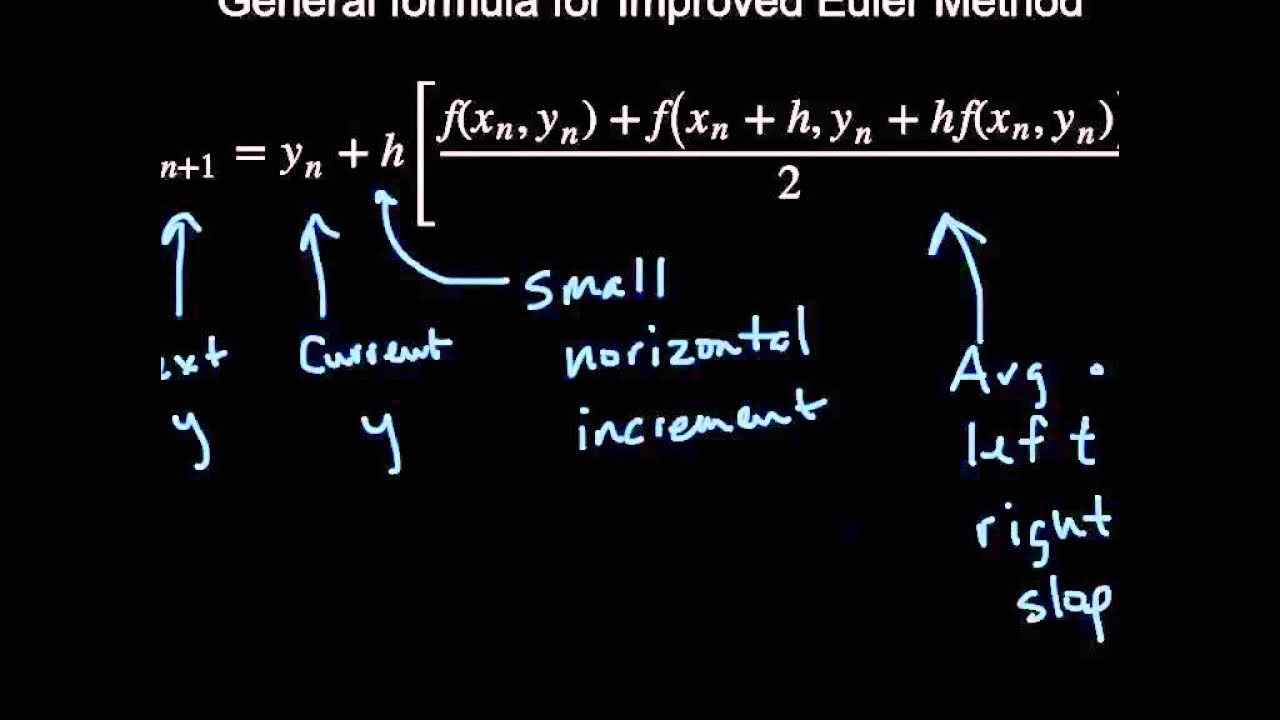Euler's Method - Example 1
TLDRThe video script provides a step-by-step demonstration of Euler's method, a numerical technique used to approximate solutions to first-order differential equations. Starting with an initial condition of y(0) = 0, the method iteratively calculates subsequent y values for increasing x values. The step size, crucial for the accuracy of the approximation, is set at 0.1 in this example. The process involves plugging the current x and y values into the differential equation (in this case, dy/dx = x + 2y) to find the next y value. The video walks through the calculations for x values of 0.1, 0.2, 0.3, and 0.4, with the final y value at x = 0.4 serving as the approximation for the solution to the differential equation at that point. The method is illustrated as a way to approximate the actual solution curve, with the understanding that the calculated points are not exact but serve as a close approximation.
Takeaways
- 📘 Euler's method is used to approximate the solution to a first-order differential equation given an initial condition.
- 🔢 The differential equation must be in a form where dy/dx is solved for, which is required for applying Euler's method.
- 📍 An initial condition, such as y(0) = 0, is necessary to start the approximation process.
- 🚀 The step size, denoted by 'h', is a crucial parameter that determines the increment in the x-coordinate for each step in the method.
- 🛑 The step size in this example is 0.1, which means the x-coordinate increases by this amount in each iteration of the method.
- 🔁 Euler's method iteratively calculates new y-values based on the previous x and y values, using the differential equation.
- 📊 The differential equation provided in the example is dy/dx = x + 2y, which is used to find the rate of change at each step.
- 📈 The x and y values are updated sequentially to generate a list of coordinates that approximate the solution curve.
- 🔍 The process involves plugging the current x and y values into the differential equation to find the next y value.
- 📐 The final y-value when x is 0.4 is the main target of the approximation in this example.
- 📝 It's important to perform the calculations carefully, and using a calculator can help ensure accuracy, especially as the process becomes more complex.
- 📉 Euler's method provides an approximation of the y-value on the solution curve, which can be plotted to visualize how closely the method follows the actual solution.
Q & A
What is the main purpose of Euler's method in the context of this example?
-The main purpose of Euler's method in this example is to approximate the value of y when x is 0.4 for a given first-order differential equation using an initial condition and a step size.
What is the initial condition provided for the differential equation in the script?
-The initial condition provided is y(0) = 0, meaning the starting point is at x = 0 and y = 0.
What is the step size (h) used in the Euler's method calculation?
-The step size (h) used in the calculation is 0.1, which determines the increment in the x-coordinate for each step in the method.
How does the differential equation dy/dx relate to the function f(x, y) in the script?
-The differential equation dy/dx is equal to the function f(x, y), which for this problem is given as x + 2y. This function is used to evaluate the change in y based on the current x and y values.
What is the formula used to calculate the next y value in Euler's method?
-The formula to calculate the next y value (y_n+1) in Euler's method is y_n + h * f(x_n, y_n), where h is the step size and f(x_n, y_n) is the differential equation evaluated at the current point (x_n, y_n).
How many steps are taken to reach the x value of 0.4 using the given step size?
-Using the step size of 0.1, it takes 4 steps to reach the x value of 0.4, starting from x = 0.
What is the x-coordinate value when y is being calculated for the first time using Euler's method?
-The x-coordinate value when y is first calculated is x = 0.1, as it is the first step from the initial x value of 0 with a step size of 0.1.
What is the calculated y value when x is 0.2 in the example?
-When x is 0.2, the calculated y value (y_2) is 0.001, obtained by plugging the previous x and y values into the differential equation and applying the Euler's method formula.
What is the final y value obtained when x reaches 0.4 in the script?
-The final y value obtained when x is 0.4 is approximately 0.0684, which is the approximation of the y value at that point using Euler's method.
How does the script illustrate the concept of Euler's method graphically?
-The script does not provide a graphical illustration but explains that the calculated x and y points (coordinates) can be plotted to visually represent how closely the points generated by Euler's method follow the actual solution curve of the differential equation.
What is the main assumption made in the script about the audience's prior knowledge?
-The script assumes that the audience already has a basic understanding of Euler's method or at least the theory behind it, and the focus is on working through an example to apply the method.
Outlines
📚 Introduction to Euler's Method
This paragraph introduces the task of using Euler's method to approximate the value of 'y' for a given differential equation when 'x' equals 0.4. It outlines the requirements for using Euler's method: a first-order differential equation, an initial condition (in this case, y(0) = 0), and a step size (h = 0.1). The paragraph emphasizes that the audience is assumed to be familiar with the theory behind Euler's method and that the video will demonstrate its application through an example. The process involves calculating new 'x' and 'y' values iteratively, starting from the initial condition and using the differential equation dy/dx = f(x, y), where f(x, y) = x + 2y for this problem.
🔢 Calculating y-values using Euler's Method
The second paragraph walks through the step-by-step calculation of 'y' values as 'x' increases from 0 to 0.4 in increments of 0.1. It explains how to use the differential equation to find the rate of change of 'y' with respect to 'x' at each step and then apply Euler's method formula to find the next 'y' value. The calculations are shown for each step, starting from y(0) = 0 and progressing through y(0.1), y(0.2), and y(0.3), until the final y value at x = 0.4 is approximated. The paragraph also includes a brief discussion on using a calculator for more complex calculations and emphasizes checking the algebra for accuracy.
📈 Approximating the Solution Curve
The final paragraph discusses the graphical representation of the solution. It mentions that the calculated points can be plotted to visualize how closely they follow the actual solution curve of the differential equation, even though Euler's method only provides an approximation. The paragraph concludes by stating that the last calculated y value is the approximation for y when x is 0.4, acknowledging the method's inherent limitations in precision but its utility in providing a close estimate.
Mindmap
Keywords
💡Euler's Method
💡Differential Equation
💡Initial Condition
💡Step Size
💡X and Y Coordinates
💡Numerical Approximation
💡Solution Curve
💡Iteration
💡Computational
💡Graphical Interpretation
💡Algebra
Highlights
The example demonstrates the use of Euler's method to approximate the y-value for a first-order differential equation when x is 0.4.
The differential equation dy/dx is given in a form that is solvable for Euler's method.
An initial condition is provided: y(0) = 0.
A step size of 0.1 is used for the calculations.
Euler's method involves taking the previous x and y values and adding the step size to find the next x value.
The formula for Euler's method is used to generate the next y value based on the previous y values.
The differential equation for the problem is x + 2y.
The process begins with the initial condition (x=0, y=0) and calculates subsequent points using the step size.
The x values are incremented by the step size to find the next coordinates.
The y value at x=0.4 is the target of the approximation.
The calculation for y1 involves plugging in the initial x and y values into the differential equation.
The calculation for y2 uses the previous x and y values (0.1, 0) to find the next y value.
The process is repeated to find y3 and y4, incrementally getting closer to the target x value of 0.4.
The final y value, y4, is the approximation for the y value when x is 0.4.
Euler's method provides an approximation of the solution curve for the differential equation.
The method generates points that follow the solution curve, approximating the true y values.
The approximation is not exact but serves as an illustration of how Euler's method can be applied.
The example concludes by emphasizing the practical application of Euler's method in approximating y values for differential equations.
Transcripts
Browse More Related Video
5.0 / 5 (0 votes)
Thanks for rating:





